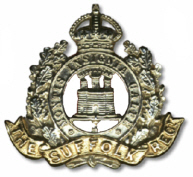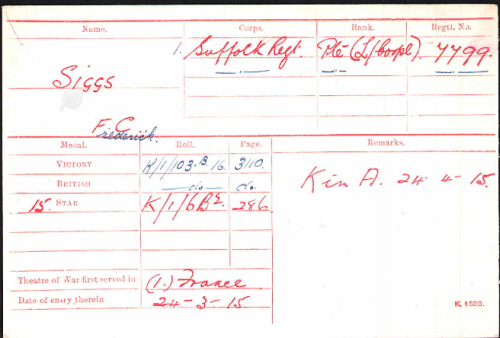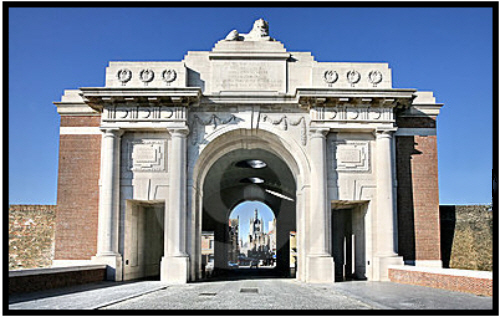



No.7799, Lance Corporal, Frederick Charles SIGGS
Aged 25

|
Frederick Charles SIGGS was born in Haverhill, (Risbridge Q4-1889 4A:625), son of Elijah and Frances SIGGS (née CLAYDON).
1891 census...Aged 1, he was at Cherry Gardens, Haverhill with his father Elijah SIGGS [30] bricklayer's labourer born Haverhill; his mother Frances [32] factory machinist, born Sturmer and widowed grandmother Charlotte CLAYDON, [66] born Helions Bumpstead. and uncle George CLAYDON [36] labourer born Sturmer. 1901 census...Aged 11, he was at Waveney Terrace, Haverhill with his parents, sister Melinda [8] born Haverhill; grandmother Charlotte CLAYDON and uncle George CLAYDON. 1911 census... Aged 21 he was in the 1st Battalion, Suffolk Regiment in Egypt, a mat maker by profession. His parents were at 66 High Street, Haverhill with his sister Melinds (a sewing machinist] and Alice [3] born Haverhill who is recorded as daughter of Frances, who had lost 2 of her five children. His mother later moved to 79 High Street, Haverhill. |

|
The South West Suffolk Echo on 26th June 1915 said:- "Lance Corporal F.Siggs, 1st Battalion, Suffolk Regt.,aged 25 years, was killed in action on 24th April 1915. He was the son of Mr. and Mrs. E.Siggs of 15 Hamlet Road. " He enlisted in Bury St. Edmunds, his number indicates around 1909. The 1st battalion returned from Khartoum to Liverpool on October 23rd 1914, and were in France by January 18th, For some reason Frederick Siggs was not on this draft. The 1st Suffolk war diary for that time has not been found, but Lt.Col. Murphy's "History of the Suffolk Regiment tells us that they were in Brigade Reserve between Frenzenberg and Verorenhoek, no shelters, bivouacking under hedges. The CO and Adjutant reached Frezenberg at dawn and soon received orders for Lt.Col. Wallace to command a mixed brigade of 1st Suffolk, 12th London and 1st Monmouth Rangers and take up a defensive position facing north east on the Frezenberg Ridge. The battalion then came under command of Captain Balders who set the men to digging in astride the Ypres-Zonnebeke Road. No sooner had they started when a staff officer told Capt Balders to take the 1st Suffolk and 12th Londons northward and attack any enemy they met.He added that the Germans had broken through and only these 2 battalions stood between the enemy and Ypres, a very critical situation. Capt Balders despite not wishing to act without his Brigade Commander's orders realised there was no time to lose, so he unhitched a horse from a gun limber and rode off to Brigade HQ. Once there he was given orders to try and establish himself in the hamlet of Fortuin. Under shell fire they moved forward and in passing Fortuin came across a Canadian HQ and was asked to use his two battalions up to help the Canadians. This he was loathe to do without orders, but when the 2 Canadian officers were hit, he decided to send the Canadians some help. The enemy fire increased and he was informed that the Germans now held St Julien. The men , out in the open, were set to dig in and overnight managed to dig a fire trench 4.5 feet deep with traverses, a remarkable feat. The situation by the 26th was so desperate that documents were being burnt, but the delaying efforts this group had given Allied reinforcements time to arrive and ease the situation. Exact figures of killed each day must of course be inaccurate in the circumstances, but CWGC records 50 killed of the 1st Suffolk on 24th, of which only 6 have known graves. " |


click here to go to the Commonwealth War Graves Commission website for full cemetery/memorial details